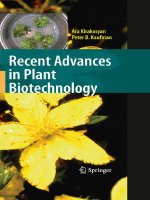advances in organobromine chemistry ii
Bạn đang xem bản rút gọn của tài liệu. Xem và tải ngay bản đầy đủ của tài liệu tại đây (15.83 MB, 441 trang )
Industrial Chemistry Library, Volume 7
Advances in Organobromine
Chemistry lI
Industrial Chemistry Library
Advisory Editor:
S.T. Sie,
Faculty of Chemical Technology and Materials Science
Delft University of Technology, Delft, The Netherlands
Volume 1
Volume 2
Volume 3
Volume 4
Volume 5
Volume 6
Volume 7
Progress in C 1 Chemistry in Japan
(Edited by the Research Association for C 1 Chemistry)
Calcium Magnesium Acetate. An Emerging Bulk Chemical for
Environmental Applications
(Edited by D.L. Wise, Y.A. Levendis and M. Metghalchi)
Advances in Organobromine Chemistry I
(Edited by J R. Desmurs and B. G6rard)
Technology of Corn Wet Milling and Associated Processes
(by EH. B lanchard)
Lithium Batteries. New Materials, Developments and Perspectives
(Edited by G. Pistoia)
Industrial Chemicals. Their Characteristics and Development
(by G. Agam)
Advances in Organobromine Chemistry II
(Edited by J R. Desmurs, B. G6rard and M.J. Goldstein)
Industrial Chemistry Library, Volume 7
Advances in Organobromine
Chemistry II
Proceedings ORGABROM '93, Jerusalem,
June 28-July 2, 1993
Edited by
Jean-Roger Desmurs
Rh6ne Poulenc Industrialisation, CRIT/CarriOres, 85 avenue des FrOres Perret,
69192 Saint-FonsCedex, France
Bernard Gdrard
Albemarle PPC, 95 rue du Gdndral De Gaulle, 68802 Thann Cedex, France
Melvin J. Goldstein
Bromine Compounds Ltd., P.O. Box 180, Beer Sheva 84101, Israel
1995
ELSEVIER
Amsterdam ~ Lausanne New York Oxford Shannon Tokyo
ELSEV1ER SCIENCE B.V.
Sara Burgerhartstraat 25
P.O. Box 211, 1000 AE Amsterdam, The Netherlands
ISBN: 0-444-82105-8
9 1995 Elsevier Science B.V. All rights reserved.
No part of this publication may be reproduced, stored in a retrieval system or transmitted in
any form or by any means, electronic, mechanical, photocopying, recording or otherwise,
without the prior written permission of the publisher, Elsevier Science B.V., Copyright &
Permissions Department, P.O. Box 521, 1000 AM Amsterdam, The Netherlands.
Special regulations for readers in the USA - This publication has been registered with
the Copyright Clearance Center Inc. (CCC), Salem, Massachusetts. Information can be
obtained from the CCC about conditions under which photocopies of parts of this publicat-
ion may be made in the USA. All other copyright questions, including photocopying outsi-
de of the USA, should be referred to the copyright owner, Elsevier Science B.V., unless
otherwise specified.
No responsibility is assumed by the publisher for any injury and/or damage to persons or
property as a matter of products liability, negligence or otherwise, or from any use or
operation of any methods, products, instructions or ideas contained in the material herein.
pp 180-201, 341-354: Copyright not transferred.
This book is printed on acid-free paper.
Printed in The Netherlands
PREFACE
This appearance of Volume 2 of "Advances in Organobromine Chemistry"
means that the "series" now happily satisfies the minimal prerequisite for such a
description. Spoken hitherto only as an act of faith by the publisher, by the
organizers, by the sponsors, and by the participants, the "series" now begins in
earnest.
Veteran readers might also recall Elsevier's 1988 publication of "Bromine
Compounds; Chemistry and Applications", what was in effect, "Volume 0" of the
subsequently designated series. That volume, like its successors, elaborated upon
the proceedings of an international conference concerned with organobromine
chemistry. The success of that first conference, like that of its succesors, depended
critically on industrial financial sponsorship. From the original 1986 conference in
Salford, principally sponsored by Associated Octel, to the 1989 conference in
Thann, principally sponsored by the Rhbne-Poulenc group, to the most recent 1993
conference in Jerusalem, principally sponsored by the Dead Sea Bromine group, the
organobromine chemical industry continues to pay more than mere lip-service to the
ideal of industrial-academic collaboration.
The number of published contributions continues also to grow with each
succeeding volume : from fourteen in "Volume 0", then to twenty-seven, and now
to thirty. Surely more important is the increasingly international character of the
contributions : initially coming from only four countries, then from nine, and now
from thirteen. Noteworthy too, if less easily quantifiable, is the increased
sophistication and quality of the contributed manuscripts.
A common truism is to believe that modern methods of transportation and
communication have transformed the world into a "global village". More accurately
perhaps, the world is being transformed into a great number of different global
villages, each one differing from the others in its focus on a particular common
culture taken in the broadest sense of that word. These are not the villages defined
by politicians or city planners. Many of them come instead, from the recognition
that nationality plays an increasingly minor role in defining the cultural
achievements of science and technology. In that context, appearance of this volume
helps to establish Organobromine Chemistry as one such global village.
Melvin J. Goldstein
Bromine Compound,
Ltd. Beer Sheva, Israel
ACKNOWLEDGEMENTS
We wish to thank the Dead Sea Bromine Group and The Hebrew University of
Jerusalem for the Organization of Orgabrom'93. Particular thanks are due to
Doctor Meir Englert, President of the organizing committee, Professor Yoel
Sasson, President of the scientific committee, and to Mrs Rickie Raz for her
valuable work in organizing the secretariat.
We wish to thank the Dead Sea Bromine Group also for the material support
that made the Orgabrom'93 congress possible.
Furthermore, we are very grateful to the ALBEMARLE Corporation for the
financial contribution which permitted the publication of this book.
Finally, we wish to thank the authors for their contribution and help in the
publication of this book.
Jean-Roger DESMURS
Bernard GERARD Melvin J. GOLDSTEIN
ORGANIZING COMMITTEE
M. ENGLERT
D. PLOTKIN
G. MEYUHAS
I. LEVITEH
R. RAZ
Y. SASSON
Dead Sea Bromine Group, Beer Sheva (Chairman)
Israel Chemicals Ltd., Tel Aviv
Gadot Petrochemical Industries Ltd., Haifa
Makhteshim Chemical Works Ltd., Beer Sheva
Dead Sea Bromine Group, Beer Sheva
The Hebrew University of Jerusalem, Jerusalem
SCIENTIFIC COMMITTEE
Y. SASSON
B.M. ADGER
J.R. DESMURS
B. GERARD
The Hebrew University of Jerusalem, Israel (Chairman)
Great Lakes Chemical Konstanz GmbH, Germany
Rhone-Poulenc Recherches, S.A., France
Rhone-Poulenc Recherches, S.A., France
VI
C. GIORDANO
M.J. GOLDSTEIN
D. MEYERSTEIN
R. NEUMANN
M.F. RUASSE
Y. SHVO
K. SMITH
O.S. TEE
H.G. VIEHE
D. VOFSI
"G. Zambon" Chemistry Research Institute, Italy
Dead Sea Bromine Group, Israel
Ben-Gurion University of the Negev, Israel
The Hebrew University of Jerusalem, Israel
Universit6 de Paris VII - C.N.R.S., France
Tel Aviv University, Israel
University College of Swansea, UK
Concordia University, Canada
Universit6 de Louvain, Belgium
The Weizmann Institute of Science, Israel
VII
This Page Intentionally Left Blank
CONTENTS
Preface V
Acknowledgements VI
Organizing Committee VI
Scientific Committee VI
INTRODUCTION
Y. Sasson
1
PREPARATION OF ORGANOBROMINATED COMPOUNDS
SYNTHESIS
Regioselective bromination of phenols
H. Eguchi, K. Tokumoto, A. Nishida, S. Fujisaki 4
Bromination of aromatic compounds with alumina-supported copper (II) bromides
M. Kodomari, H. Satoh, K. Takeuchi 17
Bromination and oxidation with benzyltrimethyl ammonium tribromide
S. Kajigaeshi, T. Kakinami 29
Advances in the synthesis and applications of organobromine compounds
K. Smith 49
High temperature bromination IV. Bromination of
benzonorbornadiene and benzobarrelene
M. Balci, A. Dastan, O. Cakmak 65
Bromination of ergolene and ergoline structures
New results
R. Rucman 77
IX
Thermal rearrangement of hexabromocyclododecane
M. Peled, R. Scharia, D. Sondack 92
PREPARATION OF ORGANOBROMINATED COMPOUNDS
REACTION MECHANISMS
Stereo-, regio- and chemoselectivity of bromination of ethylenic compounds
M F. Ruasse 100
The Fates of bromonium ions in solution 9 a very short lifetime
with many different endings
R.S. Brown 113
New mechanistic insight into the electrophilic bromination of olefins
G. Bellucci, C. Chiappe, R. Bianchini 128
USE OF ORGANOBROMINATED COMPOUNDS
SYNTHESIS
Synthesis of a metabolite of fantofarone
G. Rosseels, C. Houben, P. Kerckx 152
2-Bromoamides. Stereocomrolled substitution and application to the synthesis of
compounds of biological interest
F. D'Angeli, P. Marchetti 160
Asymmetric synthesis of (S)-(x-substituted [3-bromo-(x-hydroxy acids
S-S. Jew, J-W Kim, B.S. Jeong, Y S. Cho 171
Substrate specific reactions of dibromides of ct-arylidene-benzocyclanones with
azide nucleophile
A. Levai, E. Patonay-Peli, T. Patonay, G. T6th 174
Organobromine compounds in reactions of homolytic addition and telomerization
A.B. Terent'ev, T.T. Vasil'eva 180
Bromides in zeolite synthesis / Zeolites in bromide synthesis and conversion
H. Van Bekkum 202
An improved synthesis of biaryl derivatives via the palladium catalyzed coupling of
aryl bromides
A. Ewenson, B. Croitoru, A. Becker 217
USE OF ORGANOBROMINATED COMPOUNDS
REACTION MECHANISM
Kinetics and mechanism of decomposition of N-Br-amino acids in alkaline medium
J.M. Antelo, F. Arce, J. Crugeiras 226
Arylation of hard heteroatomic nucleophiles using bromoarenes substrates and Cu,
Ni, Pd-catalysts
H J. Cristau, J.R. Desmurs 240
Hydrogen bromide elimination from diastereomeric 3-bromoflavanones
Mechanistic aspects
T. Patonay, E. Patonay-P61i, M. Zsuga 264
Bromide-mediated oxidations of organic compounds
R.A. Sheldon 278
INDUSTRIAL ASPECTS
New catalytic process for bromine recovery
P.F. Schubert, S. Mahajan, R.D. Beatly 303
Bromine chloride production" study in a reaction calorimeter
A. Kitron 318
Influence of bromine containing fire retardants on the processing and properties of
plastics
L. Utevskii, I. Finberg, M. Muskatel, G. Reznik, J. Scheinert 323
XI
Phosphorus-bromine flame retardant synergy in engineering thermoplastics
J. Green 341
ENVIRONMENT
Treatment of bromide effluent problems with H202 technology
K.M. Reeve 355
Behavior and fate of aromatic bromine compounds in the environment
D. Lenoir 363
TOXICOLOGY
Comparison of hepatotoxicity of monobromo benzenes, dibromobenzenes,
hexabromobenzenes and tetrabromobisphenol A
Jadwiga A. Szymanska 387
ANALYSIS
The characterization of polybrominated diphenyl ether
D. Sondack, T. Ron, M.D. Kallos 399
Analysis of pentaerythritols and brominated derivatives
D. Sondack, T. Ron, M. Polishuk, M.D. Kallos 408
AUTHOR INDEX 421
SUBJECT INDEX 423
XII
INTRODUCTION
YOEL SASSON
Casali Institute of Applied Chemistry
The Hebrew University of Jerusalem, 91904 ISRAEL
At the outset of 1994 there is evidently more public (and perhaps professional)
interest in the destruction of organic halogen compounds (ref. 1) than in their
creation.
Of major concern are the health and environmental impacts of the abundant
chlorinated and brominated hydrocarbons (ref. 2). These materials have numerous
industrial applications as pesticides, solvents, propellants, refrigerants, plastics, fire
retardants and extinguishers, disinfectants for drinking water, pharmaceuticals and
electronic chemicals. Many chemical manufacturers utilize chlorinated and
brominated organics as intermediates. It is estimated, for instance, that almost 85 %
of the pharmaceuticals produced in the world require chlorine at some stage of
synthesis.
Evidence that many of these compounds can have adverse effects on the
immune, endocrine and nervous systems and that some are carcinogenic has grown
during the last decade. The role of chlorofluorocarbons (CFCs) and of methyl
bromide in the ozone layer depletion is well established (ref. 3).It is therefore not
surprising that many halogenated derivatives are cast as environmental and health
villains by various concerned groups who call for total phase out of chlorine and
chlorinated hydrocarbons.
Several of the commercially available 16,000 chlorinated and brominated
compounds have already been regulated or banned, CFCs, DDT and chlorinated
biphenyls are typical examples. Many others are being phased out according to the
Montreal Protocol on Substances that Deplete the Ozone Layer. This includes
chlorinated solvents, methyl bromide and halons (e.g. CF3Br). The milder ozone
destroyers, hydrochlorofluorocarbons (HCFCs) will also, eventually, be phased out.
Organohalogen compounds are of serious concern also as contaminants. The
most feared material in this category is dioxin (2,3,7,8-tetrachlorodibenzo-para-
dioxin, TCDD) that has already caused several catastrophes and has even been
detected in effluent and sludge from paper mills that use chlorine bleach and also in
1
the effluents of municipal and hazardous-waste incinerators (ref. 4).There are also
some evidences that chlorine based polymers (PVC), or plastics containing
brominated fire retardants, release dioxins upon burning. Concern over the
formation of trihalomethanes in drinking water is also thoroughly documented
(ref. 5).
Even so, one cannot overlook the immense advancement in development of
novel synthetic halogenation methods concomitant with an extensive progress in
comprehension of halogenation mechanisms that has taken place during the last
decade. Organohalogen compounds still find interesting new uses and applications.
The astonishing observation that the introduction of chlorine (and bromine!)
substituents enhance the sweetness of sugars by two orders of magnitude (ref. 6) has
led to the development of the trichlorinated sweetner sucralose (refs. 7,8).
Halogenated carbohydrates are finding other new uses such as antibiotics,
anticarcinogenics (ref. 9) and male antifertility agents (ref. 10). Organo bromine
compounds are practiced in numerous applications as intermediates in the
pharmaceutical industry (ref. 11). Aromatic iodine derivatives are effectual as
contrast media for diagnostic imaging by x-ray or magnetic resonance imaging
(ref. 12). New halogenation methods, such as the homolytic bromination in
supercritical carbon dioxide (ref. 13) and aromatic chlorinations in liquid HC1
(ref. 14) are being developed. Large numbers of halogenated marine natural
products have been isolated and identified. The mechanism of their biosyntheses has
been elucidated and the enzymes involved (haloperoxidases) have been isolated and
put to novel synthetic use (e.g. the enzymatic labeling of proteins with 77BrlS). The
quantities of the naturally produced halomethanes are enormous, it is estimated that
300,000 tons of methyl bromide and 5 million tons of methyl chloride are produced
annually by marine and terrestrial biomass (refs. 16,17).
Another exciting developing field is in material science. Chlorination and
bromination of fullerenes (refs. 18,19) and solid state bromination of poly-
acetylenes (refs. 20,21) and of polybutadienes (ref. 22) are typical examples.
This symposium addressed several important issues in bromine chemistry. A
major part has been devoted to stereochemistry and mechanism of electrophilic
bromination of olefins. Other topics included new selective methods of bromination
and oxybromination, brominations in presence of solid supports and catalysts,
organobromine compounds as synthons, recent developments in brominated fire
retardants and toxicological and environmental aspects of brominated compounds.
References
1. H. Windawi, M. Wyatt, Platinum Metals Rev. ,37, 186 (1993).
2. B. Hileman, Chem. & Eng. News, April 19, p.ll, (1993).
3. P.S. Zurer, Chem. & Eng. News, November 15, p. 12, (1993).
4. D.J. Hanson, Chem. & Eng. News, August 12, p. 7, (1991).
5. Kirk Othmer, Encyclopedia of Chemical Technology, 3rd Ed. Vol. 24, J. Wiley & Sons,
p. 386, New York, (1984).
6. C.E. James, L. Hough, R. Khan, Fortschr. Chem. Org. Naturst., 117 (1989).
7. M.R. Jenner, Progeress in Sweeteners, T. Grenby Ed., Elsevier, p. 121, London, (1989).
8. G.A. Miller, Changing Food Technology 2, M. Kroger, A. Freed Eds., Technomic Pub.
Co., Lancaster PA, p. 107, (1989).
9. J.F. Robyt, J.N. Zikopoulos, US patent 4 228 150 (1981). CA 94 : 90349.
10. W.C. Ford : "Progress Towards a Male Contraceptive", J. Wiley N.Y. (1982) p. 159.
11. F. de la Vega, International Symposium on Organobrominated Compounds and Their Uses,
Mulhouse-Thann, France, October 3-6, p. 193, (1989).
12. M. Sovak (to Schering), EP 406,992 (1991) CAll5 : 49124a.
13. J.M. Tanko, J.F. Blackert, Science, 263,203 (1994).
14. V.V. Smirnov, T.N. Rostovshchicova, I.G. Tarkhanova, I.N. Novikov, V.B. Barabash,
I.A. Nasyr, Kinetics & Catalysis, 34, 204 (1993).
15. F. Lambert, S. Slegers, Appl. Radiation & Radioisotopes, 45, 11 (1994).
16. A.M. Wuosmaa, L.P. Hager, Science, 249, 160 (1990).
17. G.W. Gribble, J. Nat. Prod., 55, 1353 (1992).
18. G.A. Olah, I. Bucsi, C. Lambert, R. Aniszfeld, N.J. Trivedi, D.K. Sensharma, G.K.S.
Prakash, J. Am. Chem. Soc., 113, 9385 (1991).
19. F.N. Tebbe, J.Y. Becker, D.B. Chase, L.E. Firment, E.R. Holler, B.S. Malone,
P.J. Krusic, E.W. Wasserman, J. Am. Chem. Soc., 113, 9900 (1991).
H. Eckert, J.P. Yesinowski, D.J. Sandman, C.S. Velazquez, J. Am. Chem. Soc., 109, 761
(1987).
D.J. Sandman, B.S. Elman, G.P. Hamill, C.S. Velazquez, J.P. Yesinowski, H. Eckert,
Mol. Cryst. Liq. Cryst. Lett. Sect., 4, 77 (1987).
S.F. Hahn, M.P. Dreyfuss, J. Polym. Sci. A. Polym. Chem., 31, 3039 (1993).
20.
21.
22.
REGIOSELECTIVE BROMINATION OF PHENOLS
HISAO EGUCHI
a),
KATSUMI TOKUMOTO
a),
AKIKO NISHIDA b),
and SHIZUO FUJISAKI b)
a)
Chemical Research Laboratory, Tosoh Corporation, Kaisei-cho,
Yamaguchi 746, Japan
b) Department of Applied Chemistry and Chemical Engineering,
Engineering, Yamaguchi University, Tokiwadai, Ube 755, Japan
Shinnanyo,
Faculty of
ABSTRACT
Regioselective bromination of phenols gave 2-bromo-, 4-bromo-, 2,6-dibromo-,
2,4-dibromo, 2-bromo-6-substituted, 4-bromo-2-substituted and 2,4-dibromo-6-
substituted phenols, respectively. Especially, 2-bromo-, 2,6-dibromo- and 2-bromo-
6-substituted phenols which were prepared
via long steps, were obtained in NBS-
amine (primary and secondary) system in high yields under ordinary conditions.
The scope and their mechanisms were discussed.
INTRODUCTION
Various bromophenols are useful precursors for medicinal drugs, agricultural
chemicals, dyes, and flame retardants. It is difficult to synthesize directly
ortho-
bromophenols by use of bromine with which bromination afford para-substitution
predominantly (ref. 1). Thus desired ortho-bromophenols were generally prepared
via tedious steps as shown in Scheme 1 (refs. 2,3).
OH OH OH OH
I NO 2 [ NH 2 I N2CI ~/Br
(I)
/
OH
C)
\
OH
HOjS.
SO3H
OH OH
HO3S Br I Br
v ~
SO3H (47 % from PhOH)
(2)
OH OH OH
C Br :r~~/Br
Br (73 % from PhOH)(3)
SO3H SO3H
Scheme 1. Different methods of synthesis of o-bromophenols
Several methods for direct ortho-bromination and ortho-dibromination of
phenols have been reported (refs. 4,5). Pearson et al. (ref. 6) found that treatment
of phenols with bromine in the presence of a large excess of t-butylamine at - 70~
gave 2-bromo- or 2,6-dibromophenols in good yields. Recently, Schmitz et al.
(ref. 7) showed that the reaction between phenol and N,N-dibromomethylamine
efficiently affords 2,6-dibromophenol.
However, the former reaction requires very low temperatures and very dilute
conditions and the latter uses an unstable and explosive brominating reagent.
In this article we describe selective bromination of various phenols under mild
conditions and discuss their reaction mechanisms.
REGIOSELECTIVE BROMINATION OF PHENOL
Solvent effects
Calo et al. (ref. 5) studied solvent effects on selective bromination of phenol
with NBS and found the selectivity of bromination depended on the polarity of the
solvents. But thereafter no investigation concerning the solvent effects was
reported. We report the effects systematically.
The results of the bromination of phenol with NBS compared with bromine in
various solvents are shown (Fig. 1). NBS was not added as the solution in solvent
but solid powder.
8o
40
2O
GO O0 9
100
,~ 8o
60
~
,o
O3
OO
_ 2o~, 9 ~
"
I i ! t I t I t 0 I t ,I t ! I
0 10 20 30 40 5O 10 20 30 40
Dielectric constant of
solvent Dielectric
constant of
solvent
I
Fig. 1. Plots of dielectric constant
vs
selectivity of bromination of phenol with Br 2 (left) and NBS
(solid powder) (right).
ortho-Bromophenol (A), para-Bromophenol
(o).
Although bromine leads to exclusive
para-bromide
in every solvent, it was
recognized NBS in weakly polar solvents (CC14, C6H6, C6H5Br, CHC13, CH2C12)
gave
ortho-bromide
and NBS in polar solvents (PrOH, EtOH, MeOH, DMF,
DMSO) gave
para-bromide.
Dichloromethane (DC 9 9.10) is one of the most suitable solvent for
ortho-
bromination because of its easy handling, and high solvent power for NBS.
Effects of Brominating Reagents
In Table 1 was shown the results of bromination of phenol with bromine, NBS,
and N-bromodibutylamine (NBB) (ref. 8) in dichloromethane.
Table 1. Bromination of Phenol with Bromine, NBS, and N-Bromodibutylamine (NBB) a)
Product yield (%) b)
Reagent Reagent
2,6-dibromo- 2,4,6-tribromo- 2-bromo- 2,4-dibromo-4-bromo-
/
PhOH phenol phenol phenol phenol phenol
Recovery (%)
Br 2 1.0 - - 10.7 1.0 85.7 2.6
Br 2 2.0 - 0.8 1.0 95.1 3.0 -
NBS 1.0 1.0 1.5 74.5 1.4 20.4 2.5
NBS 2.0 11.0 35.2 21.9 17.2 14.6 1.2
NBB 1.0 28.8 0.7 30.8 2.1 1.9 35.7
NBB 2.0 81.7 5.8 3.8 2.7 0.7 5.3
a) Reactions were carried out at room temperature.
b) Yields of the products were determined by GC.
Monobromination with bromine leads to exclusive 4-bromophenol, and
dibromination with the same reagent gave predominant 2,4-dibromophenol. In the
case of monobromination with NBS, the main product was 2-bromophenol, but no
selectivity appeared in the bromination using two molar amounts of NBS.
As described above, it was shown that N,N-dibromomethylamine was effective
for
ortho-dibromination
of phenol (ref. 7). We also carried out a bromination using
NBB as N-bromoamine analogue. One molar amount of NBB did not give 2-
bromophenol selectively, but gave a mixture of
ortho-monobromophenol
and 2,6-
dibromophenol, and a considerable amount of phenol was recovered. On the other
hand, 2,6-dibromophenol was obtained in an 81.7 % yield when two molar amounts
of NBB were used. These results suggested that N-bromoamines were the best
reagents for
ortho-bromination
of phenol. However N-bromoamines were very
unstable and decomposed explosively in less than a day at room temperature.
Amines Catalyzed
ortho-Bromination
(ref. 9)
We considered N-bromoamines which generated
in situ
from the reaction of
NBS and various amines, should promote the
ortho-dibromination
of phenol. The
results of the bromination with NBS in the presence of amines are summarized in
Table 2.
Table 2.
Dibromination of Phenol with NBS in the Presence of Primary, Secondary, and
Tertiary Amines a)
Amine b)
Product yield (%) c) Recovery (%)
2,6-dibromo- 2,4,6-tribromo- 2-bromo- 2,4-dibromo-4-bromo-
phenol phenol phenol phenol phenol
- 11.0 35.2 21.9 17.2 14.6 1.2
i-PrNH 2 69.3 10.5 14.4 0.7 1.4 3.8
n-BuNH 2 78.9 11.6 4.0 1.1 0.6 3.8
i-BuNH 2 65.4 16.0 11.2 0.7 0.5 6.2
(n-Pr)2NH 72.1 11.7 9.0 1.2 0.7 5.2
(i-Pr)2NH 81.8 10.7 3.2 1.4 0.8 2.2
(n-Bu)2NH 79.3 7.9 6.8 1.3 0.7 3.9
Et3N 13.6 34.8 16.1 17.4 9.6 8.5
(n-Pr)3N 10.6 38.0 13.3 17.8 11.2 9.0
(n-CsHll)3 N 18.1 34.2 11.4 17.5 13.5 5.4
a) Reactions were carried out at room temperature.
b) Molar ratio of PhOH: NBS : amine = 1:2:2.
c) Yields of the products were determined by GC.
Addition of every primary amine was effective for obtaining the
ortho-
dibromide selectively. In the absence of amines, the yield of 2,6-dibromophenol
was much lower than that of 2,4,6-tribromophenol. The selective
ortho-
dibromination of phenols was also observed when secondary amines were added.
Particularly, diisopropylamine and dibutylamine showed high
ortho-selectivity.
Addition of tertiary amines, such as triethylamine, tripropylamine, and
tripentylamine was ineffective in the~rtho-selectivity. In this system N-bromoamine
never generates.
Table 3 shows the relation between the yields of the products and the amounts
of added diisopropylamine which showed the highest
ortho-selectivity.
Table 3. Dibromination of Phenol with NBS in the Presence of Various Amounts
of (i-Pr)2NHa)
Molar
ratio Product yield
(%) b) Recovery (%)
run NBS/amine/
PhOH
2,6-dibromo- 2,4,6-tribromo- 2-bromo- 2,4-dibromo- 4-bromo-
phenol
phenol phenol phenol phenol
1 2.0/0.1/1.0 79.4 12.4 3.6 - 0.2
2 2.0/0.5/1.0 80.8 8.0 8.3 - 0.7
3 2.0/1.0/1.0 80.5 11.1 4.7 0.3 0.3
4 2.0/2.0/1.0 81.8 10.7 3.2 1.4 0.8
5 2.0/4.0/1.0 79.5 9.2 5.6 0.6 1.2
6 1.0/0.1/1.0 33.1 2.0 26.7 0.2 0.3
7 1.0/ /1.0 1.0 1.5 74.5 1.4 20.4
43
21
31
22
39
37 7
2.5
a)
Reactions were carried out at room temperature.
b)
Yields of the products were determinated
by GC.
The distribution of the products was only slightly influenced by the added amount of
the amine in the bromination. Even a 0.1 molar amount of diisopropylamine was
sufficiently effective. From these results, it was concluded that the amine worked
catalytically in the selective
ortho-bromination
of phenol. Regioselective
bromination of phenol was summarized in Scheme 2.
OH OH
)
EtOH EtOH
(58 %) (79 %)
Br Br
OH OH
o.
~ Br 2 ~.~ NBS ~ Br
CHC13 CHC13
(88 %) (85 %)
Br
OH OH
/
CHEC12 CH2C12
(95 %) (80 %)
Br
Scheme
2. Summarize of bromination of
phenol
REGIOSELECTIVE BROMINATION OF 2-SUBSTITUTED PHENOLS
Ortho-Bromination
Our method, NBS-amine system, is applied to
ortho-bromination
of 2-
substituted phenols (e.g. 2-allylphenol, o-cresol, 2-bromophenol, and 2-chloro-
phenol) (Table 4).
Table 4. Bromination of 2-Substituted Phenols with NBS, Br 2, and BTMA.Br3a)
OH OH
X l~,~ NBS, (i_Pr)2N H _X~~Br
CH2C12, rt, 1 hr
(4)
Product yield (%)c)
OH OH
Substrate Reagent b) (iPr)21~ X~Br X~
X /PhOH Br
OH OH Br
Br
Recovery
(%)
OH
Br Br 2 - 13.7 81.3 2.4
Br NBS - 18.4 22.5 29.4
Br NBS 0.1 82.0 5.7
CI Br 2 - 7.1 77.1 1.4
C1 NBS
-
27.1 17.7 24.8
C1 NBS 0.1 84.2 - 8.1
Allyl BTMA.Br 3 - - 6.5 -
Allyl NBS - 79.5 3.2 6.5
Allyl NBS 0.1 94.0 - 1.9
Me Br 2 - 2.7 94.0 0.3
Me NBS - 75.4 21.1 1.5
Me NBS 0.1 96.5 0.4 1.5
83.0
2.6
29.6
12.3
14.3
30.4
8.4
6.2 d)
10.8
4.1
2.9
2.0
1.5
a) Reactions were carried out at room temperature.
b) Molar ratio of reagent : PhOH = 1 : 1.
c) Yields of the products were determined by GC.
d) 2-Bromomethyl-2,3-dihydrobenzofuran was obtained in 4,3 9;.
10
The results were compared with the bromination with bromine. It was apparent
that bromine gave
para-bromides
exclusively except 2-allylphenol. As the reaction
of 2-allylphenol with bromine gave the mixture of many products (bromine adduct
as main product, some ring bromides as by-products, etc.), 2-allylphenol was
treated with benzyltrimethylammonium tribromide (BTMA Br3) which was already
developed as mild and easy bromine (ref. 10).
Consequently the bromine adduct was obtained in high yield (83 %). Using NBS
and a catalytic amount of the amine, the ratio of the
ortho-brominated
phenols was
remarkably raised. 2-Allylphenol and o-cresol were considerably
ortho-brominated
by NBS even without the amine. In NBS-amine system dibromides as by-products
were obtained slightly and any
para-bromide
and bromine adduct in the case of 2-
allylphenol were not detected.
In Figure 2 was shown the correlation of the reaction temperature and
selectivity of bromination of 2-substituted phenols. (eqn. 5)
OH OH OH
x
NBS (i-Pr)zNH
' ~ +
in CH 21312
Br
(5)
1 2
,, I
O
O
= ,,
03
10o
80
O
zk
60-
40 -
tl
O
A
~J
O
r
80
60
40
A
O
/k
O
t ! ! I I
-60 -40 20 0 20 40
Reaction temp. (~ Reaction temp. (~
-
080 -60-40 -20 0 20 40
Fig. 2 Selectivity of
ortho-bromide
(left) and dibromide (right) depending on reaction
temperature in the bromination of 2-substituted phenols with NBS (solid powder) and
(i-Pr)2NH. 2-allylphenol (O), o-cresol (A), 2-bromophenol (A), and 2-chlorophenol (O).
In this experiment NBS was added as solid powder. Every substrates were
converted into ortho-bromides in high yield at low temperature, but in the case of
phenols having electron-accepting groups, yield of ortho-bromides lowered and
those of by-products (dibromides) increased at high temperature (> 20~ Thus,
2,6-dihalophenols which were produced once, easily formed phenoxides ion
because of the interaction with free diisopropylamine or NHS (succinimide) and
were attacked at para-position by the excess brominating reagent at room
temperature and finally resulted in 2,4,6-trihalophenols.
Regioselective Bromination of 2-Allylphenol
It is generally supported that the bromination with NBS proceeded by a radical
(ref. 11) or an ionic mechanism via bromine molecule. For instance, the former
was suggested in benzylic and allylic bromination with NBS for Whol-Ziegler
reaction (ref. 12). Cal6 et al. (ref. 5) accounted NBS brominated phenol by the
latter mechanism.
2-Allyl-6-bromophenol, the precursor of prostacyclin analogues, is usually
prepared by the way as shown in Scheme 3 (ref. 13).
OH OH OH OH 0 "F'''~ OH
~NO~ I
(j_ _.~~l/_~~~~~,~Br ~~Br ~~
Scheme 3. Synthesis of 2-allyl-6-bromophenol
In the above section we describe the convenient preparation of 2-allyl-6-
bromophenol without any bromine adduct. It seems that these results are not able to
be explained by the mechanisms via bromine molecule, which are described later.
Useful methods for the preparation of various bromosubstituted 2-allylphenols
were proposed in Scheme 4.









